
W. G. Bagnall was a locomotive manufacturer from Stafford, England which was founded in 1875 and operated until it was taken over in 1962 by English Electric.
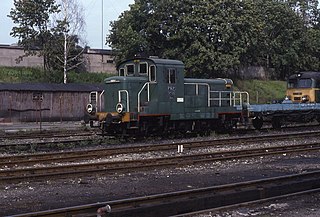
SM30 is a Polish series of diesel shunting locomotives used by PKP and industry, built by Fablok, Chrzanów. They were also used for a local traffic.

The M62 is a Soviet-built diesel locomotive for heavy freight trains, exported to many Eastern Bloc countries as well as to Cuba, North Korea and Mongolia. Beside the single locomotive M62 also twin versions 2M62 and three-section versions 3M62 have been built. A total number of 7164 single sections have been produced, which have been used to build 5231 single-, twin- and three-section locomotives.

SM42 is the PKP class for a Polish shunter diesel locomotive for shunting and light freight traffic, built by Fablok in Chrzanów.
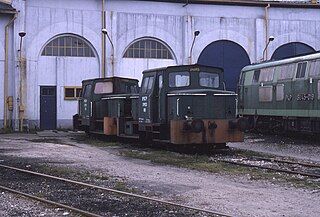
SM03 is the name of a Polish diesel locomotive class in the PKP railway operator designation. The letters SM describe a diesel shunting locomotive.
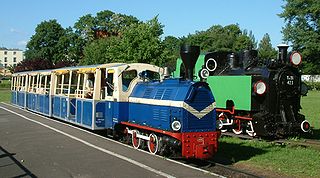
The Park Railway Maltanka is a 600 mm narrow gauge railway located in Poznań. It is 3.85 kilometres (2.4 mi) long and is owned by Miejskie Przedsiębiorstwo Komunikacyjne w Poznaniu Sp. z o.o.. The line connects Rondo Śródka and New Zoo transporting max. 150.000 passengers annually.
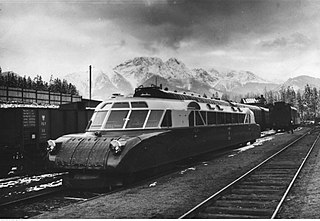
Luxtorpeda – a popular name of the famous Polish railcar from the 1930s.

Fablok is a Polish manufacturer of locomotives, based in Chrzanów. Until 1947 the official name was First Factory of Locomotives in Poland Ltd., Fablok being a widely used syllabic abbreviation of Fabryka Lokomotyw, among others as the company's telegraphic address. It is now named "BUMAR - FABLOK S.A. (corporation)". Fablok is located in the town of Chrzanów in Lesser Poland. As of 2009, Fablok no longer builds new locomotives.
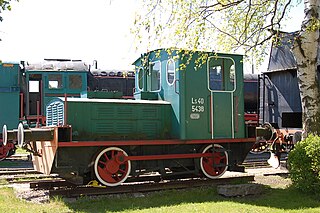
SM02 is a Polish series of diesel shunting locomotives used by PKP. 12 of the locomotives were introduced into PKP after 1954. It is the first diesel locomotive of Polish production.

Kriegslokomotiven or Kriegsloks were locomotives produced in large numbers during the Second World War under Nazi Germany. Their construction was tailored to the economic circumstances of wartime Germany along with conquered and occupied territories across Europe, taking account of the shortage of materials, the transportation of goods in support of military logistics, ease of maintenance under difficult conditions, resistance to extreme weather, limited life and the need for rapid, cheap mass production. In order to meet these requirements, economic drawbacks such as relatively high fuel consumption had to be accepted. Forced labour was used in the construction of some of the locomotives; German locomotive building firms employed prisoners from concentration camps and foreign, mostly Polish, workers.

Pesa is a Polish company manufacturing railway vehicles based in Bydgoszcz. The name 'Pesa' derives from the initials PS which stand for Pojazdy Szynowe, 'railway vehicles' in Polish. Pesa is a successor to the Bydgoszcz repair shops of PKP Polskie Koleje Państwowe, Polish State Railways. From the 1950s until 1998 the repair shops operated under the name ZNTK Bydgoszcz, Zakłady Naprawcze Taboru Kolejowego, 'Repair Shop for Railway Rolling Stock' in Bydgoszcz.

The Fablok T3A also known as TKh49 or Ferrum 47 / 724 is a class of Polish steam industrial tank locomotive. It was built by Fablok in 1948-1961 years.
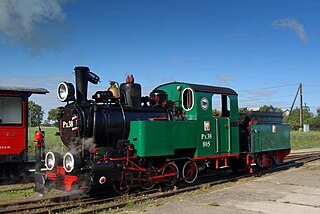
Px38-805, named Leon, is a preserved Polish 600 mm narrow gauge steam locomotive built by Fablok in Chrzanów, Poland. It was the only locomotive of PKP class Px38, and one of three built locomotives of Fablok W5A type.

The PKP class Lyd1 is a narrow gauge diesel locomotive class, covering two similar models built in Poland: WLs150 built by Fablok, and its development WLs180 (803D) manufactured by Zastal. It was used by Polish State Railways (PKP) on the narrow gauge railways in Poland, and on industrial railways.

The WLs75 is a small narrow gauge diesel locomotive built in Poland, at the ZNTK in Poznań. It was used mostly on industrial railways.

Px27 is a class of Polish State Railways (PKP) 600 mm narrow-gauge steam locomotive built by Fablok in Chrzanów, Poland, in 1929. Only two locomotives of this class were made, and one, Px27-775, is currently preserved.
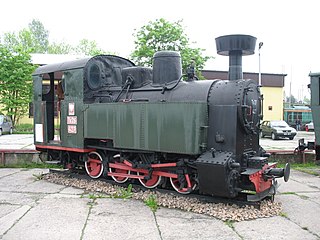
Tx26-427 is a preserved Polish 600 mm narrow gauge steam locomotive built by Fablok in Chrzanów, Poland. It was the only locomotive of Fablok W2A type, included into PKP class Tx26 along with W1A type.

PKP Class Pt31 is a Polish steam locomotive of Polskie Koleje Państwowe, designed for hauling heavy long-distance passenger trains, built in 1932-1940. The designation stood for fast passenger (P) 2-8-2 (t) steam locomotive designed in 1931.

PKP Class Pu29 is a Polish steam locomotive of Polskie Koleje Państwowe, designed for hauling heavy long-distance passenger trains, built in 1931. The designation stood for fast passenger (P) 4-8-2 (u) steam locomotive accepted in 1929.
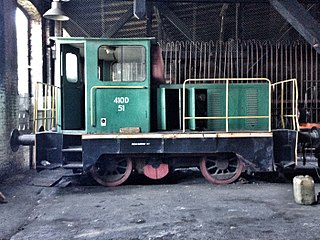
The Zastal 410D is a diesel shunting locomotive produced by Zaodrzańskich Zakładach Przemysłu Metalowego im. M. Nowotki in Zielonej Górze. Designed to perform shunting operations on industrial sidings, a total of 51 examples were produced from 1973–1975.




















